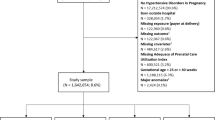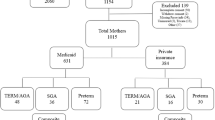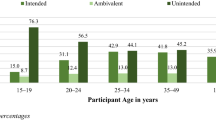Abstract
Objective
The primary objective was to determine the association between preconception insurance and initiation of prenatal care.
Study design
This retrospective cohort uses data from the Pregnancy Risk Assessment Monitoring System (2009–2013). Self-reported preconception insurance status was the primary exposure. The primary outcome was first trimester initiation of prenatal care. Secondary outcomes included: preterm delivery, birth weight, and the presence of birth defects. Survey-weighted generalized linear models were used to calculate risk ratios and accounted for state-level clustering.
Results
Of the 181,675 included women from 32 states, 21.1% were uninsured prior to conception. 88% of insured women vs. 70% of uninsured women initiated care in the first trimester. Uninsured women were less likely to initiate care in the first trimester (adjusted relative risk (RR) 0.87 (95% confidence interval 0.85–0.89), p < 0.001) compared to women with insurance in the adjusted analysis. Among the secondary outcomes, uninsured nulliparous women had a 20% higher risk of extremely (<28 weeks) preterm delivery than those with preconception insurance (adjusted RR 1.20 (1.03–1.39), p = 0.01). Uninsured women also had a slightly increased risk of having SGA infant compared to insured women (adjusted RR 1.04 (1.01–1.09), p = 0.02). There were no differences in the other secondary outcomes.
Conclusions
Preconception insurance is associated with earlier initiation of prenatal care.
This is a preview of subscription content, access via your institution
Access options
Subscribe to this journal
Receive 12 print issues and online access
$259.00 per year
only $21.58 per issue
Buy this article
- Purchase on Springer Link
- Instant access to full article PDF
Prices may be subject to local taxes which are calculated during checkout

Similar content being viewed by others
References
Centers for Disease Control and Prevention (CDC). FastStats-Births and Natality. https://www.cdc.gov/nchs/fastats/births.htm. 2017. Accessed 10 Nov. 2017.
Daw JR, Hatfield LA, Swartz K, Sommers BD.Women in the United States experience high rates of coverage “Churn” In months before and after childbirth. Health Aff Proj Hope. 2017;36:598–606.
Kozhimannil KB, Abraham JM, Virnig BA. National trends in health insurance coverage of pregnant and reproductive-age women, 2000 to 2009. Womens Health Issues. 2012;2:e135–141.
D’Angelo DV, Le B, O’Neil ME, Williams L, Ahluwalia IB, Harrison LL. et al. Patterns of health insurance coverage around the time of pregnancy among women with live-born infants--pregnancy risk assessment monitoring system, 29 States, 2009. Vol. 6. Morbidity and Mortal Weekly Report Surveillance Summaries, Washington DC, 2002; 2015. pp. 1–19.
Sommers BD, Gawande AA, Baicker K. Health insurance coverage and health - what the recent evidence tells us. N Engl J Med. 2017;377:586–93.
Centers for Disease Control and Prevention (CDC) Pregnancy risk assessment monitoring system. https://www.cdc.gov/prams. 2017. Accessed 27 Sept. 2017.
Department of Health and Human Services. About the ACA. Health and Human Services. https://www.hhs.gov/healthcare/about-the-aca/index.html. 2013. Accessed 2 Oct. 2017.
Atrash HK, Johnson K, Adams M, Cordero JF. Preconception care for improving perinatal outcomes: the time to act. Matern Child Health J. 2006;10(Suppl 1):3–11.
Stephenson J, Heslehurst N, Hall J, Schoenaker DAJM, Hutchinson J, Cade JE. et al. Before the beginning: nutrition and lifestyle in the preconception period and its importance for future health. Lancet. 2018;391:1830–41.
Recommendations to Improve Preconception Health and Health Care---United States. A Report of the CDC/ATSDR Preconception Care Work Group and the Select Panel on Preconception Care https://www.cdc.gov/mmwr/preview/mmwrhtml/rr5506a1.htm. 2018. Accessed 11 May 2018.
Wally MK, Huber LRB, Issel LM, Thompson ME. The association between preconception care receipt and the timeliness and adequacy of prenatal care: an examination of multistate data from Pregnancy Risk Assessment Monitoring System (PRAMS) 2009–2011. Matern Child Health J. 2018;22:41–50.
Arth AC, Tinker SC, Simeone RM, Ailes EC, Cragan JD, Grosse SD. Inpatient hospitalization costs associated with birth defects among persons of all ages-United States, 2013. MMWR Morb Mortal Wkly Rep. 2017;66:41–6.
Korvenranta E, Lehtonen L, Rautava L, Häkkinen U, Andersson S, Gissler M, et al. Impact of very preterm birth on health care costs at five years of age. Pediatrics. 2010;125:e1109–1114.
Grosse SD, Waitzman NJ, Yang N, Abe K, Barfield WD. Employer-sponsored plan expenditures for infants born preterm. Pediatrics. 2017;140. pii: e20171078
Trussell J. The cost of unintended pregnancy in the United States. Contraception. 2007;75:168–70.
Health Insurance Coverage of Women 19-64. The Henry J. Kaiser Family Foundation. https://www.kff.org/other/state-indicator/nonelderly-adult-women/. 2017. Accessed 16 Oct. 2017.
Dietz P, Bombard J, Mulready-Ward C, Gauthier J, Sackoff J, Brozicevic P. et al. Valididity Selected Item-2003 U S Standard Certificate live birth: New York City Vt. 2015;130:60–70. Public Health Report, Washington DC; 1974.
Dietz PM, Bombard JM, Hutchings YL, Gauthier JP, Gambatese MA, Ko JY, et al. Validation of obstetric estimate of gestational age on US birth certificates. Am J Obstet Gynecol. 2014;210:335.e1–335.e5.
Dietz P, Bombard J, Mulready-Ward C, Gauthier J, Sackoff J, Brozicevic P, et al. Validation of self-reported maternal and infant health indicators in the Pregnancy Risk Assessment Monitoring System. Matern Child Health J. 2014;18:2489–98.
Acknowledgements
The data were provided by the Centers for Disease Control and Prevention and the Pregnancy Risk Assessment Monitoring System (PRAMS) working group. A full list of working group members can be found online at https://www.cdc.gov/prams/researchers.htm.
Author information
Authors and Affiliations
Corresponding author
Ethics declarations
Conflict of interest
The authors declare that they have no conflict of interest.
Rights and permissions
About this article
Cite this article
Clapp, M.A., James, K.E. & Kaimal, A.J. Preconception insurance and initiation of prenatal care. J Perinatol 39, 300–306 (2019). https://doi.org/10.1038/s41372-018-0292-7
Received:
Revised:
Accepted:
Published:
Issue Date:
DOI: https://doi.org/10.1038/s41372-018-0292-7



